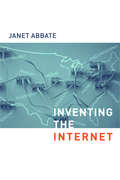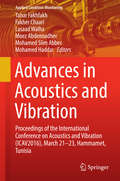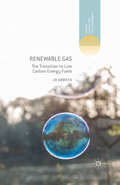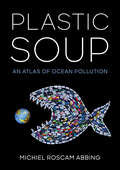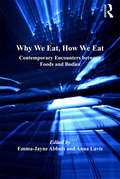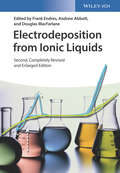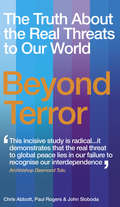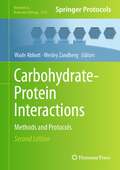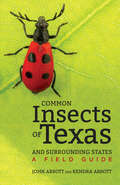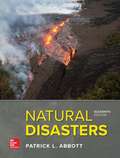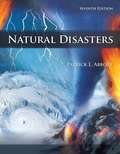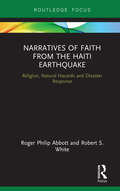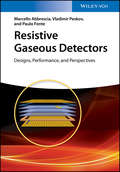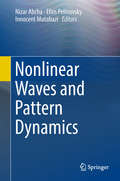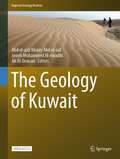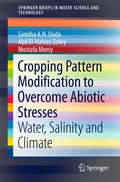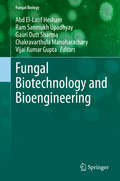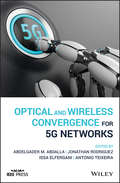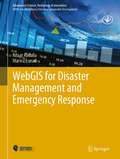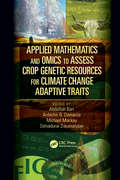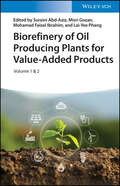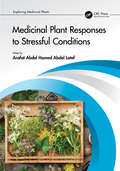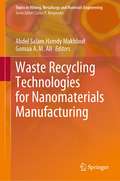- Table View
- List View
Inventing the Internet (Inside Technology)
by Janet AbbateJanet Abbate recounts the key players and technologies that allowed the Internet to develop; but her main focus is always on the social and cultural factors that influenced the Internet's design and use.Since the late 1960s the Internet has grown from a single experimental network serving a dozen sites in the United States to a network of networks linking millions of computers worldwide. In Inventing the Internet, Janet Abbate recounts the key players and technologies that allowed the Internet to develop; but her main focus is always on the social and cultural factors that influenced the Internets design and use. The story she unfolds is an often twisting tale of collaboration and conflict among a remarkable variety of players, including government and military agencies, computer scientists in academia and industry, graduate students, telecommunications companies, standards organizations, and network users.The story starts with the early networking breakthroughs formulated in Cold War think tanks and realized in the Defense Department's creation of the ARPANET. It ends with the emergence of the Internet and its rapid and seemingly chaotic growth. Abbate looks at how academic and military influences and attitudes shaped both networks; how the usual lines between producer and user of a technology were crossed with interesting and unique results; and how later users invented their own very successful applications, such as electronic mail and the World Wide Web. She concludes that such applications continue the trend of decentralized, user-driven development that has characterized the Internet's entire history and that the key to the Internet's success has been a commitment to flexibility and diversity, both in technical design and in organizational culture.
Advances in Acoustics and Vibration: Proceedings of the International Conference on Acoustics and Vibration (ICAV2016), March 21-23, Hammamet, Tunisia (Applied Condition Monitoring #5)
by Mohamed Slim Abbes Fakher Chaari Mohamed Haddar Tahar Fakhfakh Lasaad Walha Moez AbdennadherThe book provides readers with a snapshot of recent research and industrial trends in field of industrial acoustics and vibration. Each chapter, accepted after a rigorous peer-review process, reports on a selected, original piece of work presented and discussed at International Conference on Acoustics and Vibration (ICAV2016), which was organized by the Tunisian Association of Industrial Acoustics and Vibration (ATAVI) and held March 21-23, in Hammamet, Tunisia. The contributions, mainly written by north African authors, covers advances in both theory and practice in a variety of subfields, such as: smart materials and structures; fluid-structure interaction; structural acoustics as well as computational vibro-acoustics and numerical methods. Further topics include: engines control, noise identification, robust design, flow-induced vibration and many others. This book provides a valuable resource for both academics and professionals dealing with diverse issues in applied mechanics. By combining advanced theories with industrial issues, it is expected to facilitate communication and collaboration between different groups of researchers and technology users.
Renewable Gas: The Transition to Low Carbon Energy Fuels (Energy, Climate and the Environment)
by Jo AbbessThe author looks at the prospects for a transition from natural gas to low carbon gas, which could take several decades, and at how this will depend on the evolution of the fossil fuel industry. She investigates the technologies and energy systems for making the best use of renewable gas resources.
Plastic Soup: An Atlas of Ocean Pollution
by Michiel Roscam AbbingPlastics have transformed every aspect of our lives. Yet the very properties that make them attractive—they are cheap to make, light, and durable—spell disaster when trash makes its way into the environment. Plastic Soup: An Atlas of Ocean Pollution is a beautifully-illustrated survey of the plastics clogging our seas, their impacts on wildlife and people around the world, and inspirational initiatives designed to tackle the problem. In Plastic Soup, Michiel Roscam Abbing of the Plastic Soup Foundation reveals the scope of the issue: plastic trash now lurks on every corner of the planet. With striking photography and graphics, Plastic Soup brings this challenge to brilliant life for readers. Yet it also sends a message of hope; although the scale of the problem is massive, so is the dedication of activists working to check it. Plastic Soup highlights a diverse array of projects to curb plastic waste and raise awareness, from plastic-free grocery stores to innovative laws and art installations. According to some estimates, if we continue on our current path, the oceans will contain more plastic than fish by the year 2050. Created to inform and inspire readers, Plastic Soup is a critical tool in the fight to reverse this trend.
Why We Eat, How We Eat: Contemporary Encounters between Foods and Bodies (Critical Food Studies)
by Emma-Jayne Abbots Anna LavisWhy We Eat, How We Eat maps new terrains in thinking about relations between bodies and foods. With the central premise that food is both symbolic and material, the volume explores the intersections of current critical debates regarding how individuals eat and why they eat. Through a wide-ranging series of case studies it examines how foods and bodies both haphazardly encounter, and actively engage with, one another in ways that are simultaneously material, social, and political. The aim and uniqueness of this volume is therefore the creation of a multidisciplinary dialogue through which to produce new understandings of these encounters that may be invisible to more established paradigms. In so doing, Why We Eat, How We Eat concomitantly employs eating as a tool - a novel way of looking - while also drawing attention to the term 'eating' itself, and to the multiple ways in which it can be constituted. The volume asks what eating is - what it performs and silences, what it produces and destroys, and what it makes present and absent. It thereby traces the webs of relations and multiple scales in which eating bodies are entangled; in diverse and innovative ways, contributors demonstrate that eating draws into relationships people, places and objects that may never tangibly meet, and show how these relations are made and unmade with every mouthful. By illuminating these contemporary encounters, Why We Eat, How We Eat offers an empirically grounded richness that extends previous approaches to foods and bodies.
Electrodeposition from Ionic Liquids
by Andrew Abbott Douglas Macfarlane Frank EndresEdited by distinguished experts in this expanding field and with specialist contributions, this overview is the first of its kind to focus on electrodeposition from ionic liquids. This second edition has been completely revised and updated with approximately 20% new content and has been expanded by five chapters to cover the following topics: -Bulk and Interface Theory -Nanoscale Imaging including AFM, In situ STM and UHV-STM -Impedance Spectroscopy -Process Scale-up including Brighteners -Speciation and Redox Properties. The result is essential reading for electrochemists, materials scientists, chemists in industry, physical chemists, chemical engineers, inorganic and organic chemists.
Beyond Terror: The Truth About the Real Threats to Our World
by Chris Abbott John Sloboda Paul RogersIs international terrorism really the single greatest threat to world security?Since the 9/11 attacks, many Western governments assume terrorism to be the greatest threat we face. In response, their dangerous policies attempt to maintain control and keep the status quo by using overwhelming military force. This important book shows why this approach has been such a failure, and how it distracts us from other, much greater, threats of climate change, competition over resources, marginalisation of the majority of the world and global militarisation.Unless urgent, coordinated action is taken in the next 5-10 years on all these issues it will be almost imossible to avoid the earth becoming a highly unstable place by the middle years of this century. Beyond Terror offers an alternative path for politicians, journalists and concerned citizens alike.
Carbohydrate-Protein Interactions: Methods and Protocols (Methods in Molecular Biology #2657)
by D. Wade Abbott Wesley F. ZandbergThis second edition provides new and updated tools for studying protein-carbohydrate interactions ranging from traditional biochemical methods to state-of-the-art techniques. This book focuses on four different research themes detailing methods for screening and quantifying CAZyme activity, investigating the interactions between proteins, carbohydrate ligands, methods for the visualization of carbohydrates, protein-carbohydrate complexes, structural and “omic” approaches for studying systems of CAZymes. Written in the format of the highly successful Methods in Molecular Biology series, each chapter includes an introduction to the topic, lists necessary materials and methods, includes tips on troubleshooting and known pitfalls, and step-by-step, readily reproducible protocols. Authoritative and cutting-edge, Carbohydrate- Protein Interactions: Methods and Protocols, Second Edition aims to be comprehensive guide for researchers in the field.
Damselflies of Texas
by John C. AbbottOn any warm summer day, you can easily observe damselflies around a vegetated pond or the rocks along the banks of a stream. Like the more familiar dragonfly, damselflies are among the most remarkably distinctive insects in their appearance and biology, and they have become one of the most popular creatures sought by avocational naturalists. Damselflies of Texas is the first field guide dedicated specifically to the species found in Texas. It covers 77 of the 138 species of damselflies known in North America, making it a very useful guide for the entire United States. Each species account includes:- illustrations of as many forms (male, female, juvenile, mature, and color morphs) as possible- common and scientific names, with pronunciation- distribution map- key features- identifying characteristics- discussion of similar species- status in Texas- habitat, seasonality, and general commentsIn addition to photographing damselflies in the wild, the author and illustrator have developed a new process for illustrating each species by scanning preserved specimens and digitally painting them. The resulting illustrations show detail that is not visible in photographs. The book also contains chapters on damselfly anatomy, life history, conservation, names, and photography, as well as a list of species that may eventually be discovered in Texas, state and global conservation rankings, seasonality of all species in chronological order, and additional resources and publications on the identification of damselflies.
Common Insects of Texas and Surrounding States: A Field Guide
by John C. Abbott Kendra AbbottA comprehensive field guide to Texas&’s insects, featuring 1,300 species and over 2,700 photographs. Thanks to its size and geographic position, Texas is home to nearly 30,000 species of insects, likely making its insect population the most diverse in the nation. Ranging from eastern and western to temperate and tropical species, this vast array of insects can be difficult to identify. In Common Insects of Texas and Surrounding States, John and Kendra Abbott have created the state&’s most comprehensive field guide to help readers recognize and understand these fascinating creatures. Containing 1,300 species and more than 2,700 photographs, this guide offers a wealth of information about the characteristics and behaviors of Texas&’s insects. Each chapter introduces an order with a discussion of general natural history and a description of other qualities helpful in distinguishing its various species, while every species&’ entry provides a state map showing where it is most likely to be found, a key displaying its seasonal distribution, information about its habitat, and corresponding photos. Featuring colored tabs for quick reference, a glossary, and information about other arthropods, this guide is the perfect companion for anyone wanting to identify and learn more about the many insects of Texas.&“Expertly written and beautifully illustrated, this exceptional book will be of interest to both professional and beginning naturalists.&” —Edward O. Wilson, University Research Professor Emeritus, Harvard University
Common Insects of Texas and Surrounding States: A Field Guide
by John C. Abbott Kendra AbbottA comprehensive field guide to Texas&’s insects, featuring 1,300 species and over 2,700 photographs. Thanks to its size and geographic position, Texas is home to nearly 30,000 species of insects, likely making its insect population the most diverse in the nation. Ranging from eastern and western to temperate and tropical species, this vast array of insects can be difficult to identify. In Common Insects of Texas and Surrounding States, John and Kendra Abbott have created the state&’s most comprehensive field guide to help readers recognize and understand these fascinating creatures. Containing 1,300 species and more than 2,700 photographs, this guide offers a wealth of information about the characteristics and behaviors of Texas&’s insects. Each chapter introduces an order with a discussion of general natural history and a description of other qualities helpful in distinguishing its various species, while every species&’ entry provides a state map showing where it is most likely to be found, a key displaying its seasonal distribution, information about its habitat, and corresponding photos. Featuring colored tabs for quick reference, a glossary, and information about other arthropods, this guide is the perfect companion for anyone wanting to identify and learn more about the many insects of Texas.&“Expertly written and beautifully illustrated, this exceptional book will be of interest to both professional and beginning naturalists.&” —Edward O. Wilson, University Research Professor Emeritus, Harvard University
Natural Disasters
by Patrick Leon AbbottNatural Disasters, 11th edition focuses on explaining how the normal processes of Earth concentrate their energies and deal heavy blows to humans and their structures. Students have a natural curiosity about natural disasters and why they occur. This text explains why natural disasters occur by interweaving the themes of Energy sources, Plate tectonics, climate change, Earth Processes, geologic time, the complexities of multiple variables operating simultaneously throughout the text. Detailed and interesting Case histories are also intertwined with current content to give students a broad historical understanding of our dynamic and evolving planet.
Natural Disasters (7th edition)
by Patrick Leon AbbottNatural Disasters, 7th edition, focuses on how the normal processes of the Earth concentrate their energies and deal heavy blows to humans and their structures. It is concerned with how the natural world operates and, in so doing, kills and maims humans and destroys their works. Throughout the book, certain themes are maintained: energy sources underlying disasters plate tectonics and climate change; earth processes operating in rock, water, and atmosphere; significance of geologic time; complexities of multiple variables operating simultaneously; detailed and readable case studies.
Narratives of Faith from the Haiti Earthquake: Religion, Natural Hazards and Disaster Response (Routledge Focus on Religion)
by Roger Philip Abbott Robert S. WhiteThis book presents an in-depth ethnographic case study carried out in the years following the 2010 Haiti earthquake to present the role of faith beliefs in disaster response. The earthquake is one of the most destructive on record, and the aftermath, including a cholera epidemic and ongoing humanitarian aid, has continued for years following the catastrophe. Based on dozens of interviews, this book gives primacy to survivors’ narratives. It begins by laying out the Haitian context, before presenting an account of the earthquake from survivors’ perspectives. It then explores in detail how the earthquake affected the religious, mainly Christian, faith of survivors and how religious faith influenced how they responded to, and are recovering from, the experience. The account is also informed by geoscience and the accompanying "complicating factors." Finally, the Haitian experience highlights the significant role that religious faith can play alongside other learned coping strategies in disaster response and recovery globally. This book contributes an important case study to an emerging literature in which the influence of both religion and narrative is being recognised. It will be of interest to scholars of any discipline concerned with disaster response, including practical theology, anthropology, psychology, geography, Caribbean studies and earth science. It will also provide a resource for non-governmental organisations.
Resistive Gaseous Detectors: Designs, Performance, and Perspectives
by Marcello Abbrescia Vladimir Peskov Paulo FonteThis first book to critically summarize the latest achievements and emerging applications within this interdisciplinary topic focuses on one of the most important types of detectors for elementary particles and photons: resistive plate chambers (RPCs). In the first part, the outstanding, international team of authors comprehensively describes and presents the features and design of single and double-layer RPCs before covering more advanced multi-layer RPCs. The second part then focuses on the application of RPCs in high energy physics, materials science, medicine and security. Throughout, the experienced authors adopt a didactic approach, with each subject presented in a simple way, increasing in complexity step by step.
Nonlinear Waves and Pattern Dynamics
by Nizar Abcha Efim Pelinovsky Innocent MutabaziThis book addresses the fascinating phenomena associated with nonlinear waves and spatio-temporal patterns. These appear almost everywhere in nature from sand bed forms to brain patterns, and yet their understanding still presents fundamental scientific challenges. The reader will learn here, in particular, about the current state-of-the art and new results in: Nonlinear water waves: resonance, solitons, focusing, Bose-Einstein condensation, as well as and their relevance for the sea environment (sea-wind interaction, sand bed forms, fiber clustering) Pattern formation in non-equilibrium media: soap films, chimera patterns in oscillating media, viscoelastic Couette-Taylor flow, flow in the wake behind a heated cylinder, other pattern formation. The editors and authors dedicate this book to the memory of Alexander Ezersky, Professor of Fluid Mechanics at the University of Caen Normandie (France) from September 2007 to July 2016. Before 2007, he had served as a Senior Scientist at the Institute of Applied Physics of the Russian Academy of Sciences in Nizhny Novgorod (Russia). The chapters have been written by leading scientists in Nonlinear Physics, and the topics chosen so as to cover all the fields to which Prof. Ezersky himself contributed, by means of experimental, theoretical and numerical approaches. The volume will appeal to advanced students and researchers studying nonlinear waves and pattern dynamics, as well as other scientists interested in their applications in various natural media.
The Geology of Kuwait (Regional Geology Reviews)
by Abd el-aziz Khairy Abd el-aal Jasem Mohammed Al-Awadhi Ali Al-DousariThis open access book contains a set of chapters covering all aspects of geosciences related to Kuwait and adjacent regions, including Iran, Saudi Arabia and the Arab Gulf states. It covers basic information about the geology including a wide range of geoscientific disciplines such as marine geology, structural geology, hydrogeology and geophysics related to the region. This book is aimed at researchers and students, as well as professionals in the field of hazard mitigation and petroleum exploration.
Cropping Pattern Modification to Overcome Abiotic Stresses: Water, Salinity and Climate (SpringerBriefs in Water Science and Technology)
by Abd El-Hafeez Zohry Samiha A. H. Ouda Mostafa MorsyThis book provides state-of-the art analysis, never done before in Egypt, on agro-climatic zones level. This study deals with how the national cropping pattern can be modified to overcome abiotic stresses, such as water scarcity, induced salinity and climate change to reduce their negative effects on food production. To this end, different cropping patterns are suggested. This study can be a framework for other developing countries to be used in quantifying and filling the gap in their knowledge about practices that can help in increasing their food security through increasing food production. Furthermore, the study is useful for policy makers to help them in their future plans and policies.
Fungal Biotechnology and Bioengineering (Fungal Biology)
by Abd El-Latif Hesham Ram Sanmukh Upadhyay Gauri Dutt Sharma Chakravarthula Manoharachary Vijai Kumar GuptaFungi are eukaryotic microorganisms that include both unicellular and multicellular species. They have a worldwide distribution and a wide range of applications in diverse sectors, from environmental, food and medicine to biotechnological innovations. Fungal biochemical genetics involves the study of the relationships between genome, proteome and metabolome, and the underlying molecular processes in both native and bioengineered fungi. This book provides a valuable resource on the challenges and potential of fungal biotechnology and related bioengineering and functional diversity for various industrial applications in the food, environmental, bioenergy and biorefining, and the biopharma sectors. In comparison to previous and related publications in the area of applied myco-biotech-engineering, this book bridges a knowledge gap in the areas related to prospects and investment as well as intellectual and technical issues. This book also provides information on recent commercial and economic interests in the area by juxtaposing the developments achieved in recent worldwide research and its many challenges.
Optical and Wireless Convergence for 5G Networks (Wiley - IEEE)
by Abdelgader M AbdallaThe mobile market has experienced unprecedented growth over the last few decades. Consumer trends have shifted towards mobile internet services supported by 3G and 4G networks worldwide. Inherent to existing networks are problems such as lack of spectrum, high energy consumption, and inter-cell interference. These limitations have led to the emergence of 5G technology. It is clear that any 5G system will integrate optical communications, which is already a mainstay of wide area networks. Using an optical core to route 5G data raises significant questions of how wireless and optical can coexist in synergy to provide smooth, end-to-end communication pathways. Optical and Wireless Convergence for 5G Networks explores new emerging technologies, concepts, and approaches for seamlessly integrating optical-wireless for 5G and beyond. Considering both fronthaul and backhaul perspectives, this timely book provides insights on managing an ecosystem of mixed and multiple access network communications focused on optical-wireless convergence. Topics include Fiber–Wireless (FiWi), Hybrid Fiber-Wireless (HFW), Visible Light Communication (VLC), 5G optical sensing technologies, approaches to real-time IoT applications, Tactile Internet, Fog Computing (FC), Network Functions Virtualization (NFV), Software-Defined Networking (SDN), and many others. This book aims to provide an inclusive survey of 5G optical-wireless requirements, architecture developments, and technological solutions.
WebGIS for Disaster Management and Emergency Response (Advances in Science, Technology & Innovation)
by Rifaat Abdalla Marwa EsmailThis book aims to help students, researchers and policy makers understand the latest research and development trends in the application of WebGIS for Disaster Management and Emergency Response. It is designed as a useful tool to better assess the mechanisms for planning, response and mitigation of the impact of disaster scenarios at the local, regional or national levels. It contains details on how to use WebGIS to solve real-world problems associated with Disaster Management Scenarios for the long-term sustainability. The book broadens the reader understanding of the policy and decision-making issues related to Disaster Management response and planning.
Applied Mathematics and Omics to Assess Crop Genetic Resources for Climate Change Adaptive Traits
by Abdallah Bari, Ardeshir B. Damania, Michael Mackay and Selvadurai DayanandanApplied Mathematics and Omics to Assess Crop Genetic Resources for Climate Change Adaptive Traits focuses on practical means and approaches to further the use of genetic resources for mitigating the effects of climate change and improving crop production. Genetic diversity in crop plants is being further explored to increase yield, disease resistance, and nutritional value by employing recent advances in mathematics and omics technologies to promote the adaptation of crops to changing climatic conditions. This book presents a broad view of biodiversity and genetic resources in agriculture and provides answers to some current problems. It also highlights ways to provide much-needed information to practitioners and innovators engaged in addressing the effects of global climate change on agriculture. The book is divided into sections that cover: The implications of climate change for drylands and farming communities The potential of genetic resources and biodiversity to adapt to and mitigate climate change effects Applications of mathematics and omics technologies Genomics and gene identification We are in the midst of significant changes in global climates, and its effects are already being felt throughout the world. The increasing frequency of droughts and heat waves has had negative impacts on agricultural production, especially in the drylands of the world. This book shares the collective knowledge of leading scientists and practitioners, giving readers a broader appreciation and heightened awareness of the stakes involved in improving and sustaining agricultural production systems in the face of climate change.
Biorefinery of Oil Producing Plants for Value-Added Products
by Suraini Abd-Aziz Misri Gozan Mohamad Faizal Ibrahim Lai-Yee PhangBiorefinery of Oil Producing Plants for Value-Added Products An instructive and up-to-date pretreatment and industrial applications of oil producing plants Biorefinery of Oil Producing Plants for Value-Added Products is a two-volume set that delivers a comprehensive exploration of oil producing plants, from their availability to their pretreatment, bioenergy generation, chemical generation, bioproduct generation, and economic impact. The distinguished team of editors has included a wide variety of highly instructive resources written by leading contributors to the field. This set explores the current and future potential of bioenergy production to address the energy and climate crisis, as well as the technologies used to produce materials like biogas, biodiesel, bioethanol, biobutanol, biochar, fuel pellets, and biohydrogen. It also discusses the production of biobased chemicals, including bio-oil, biosurfactants, catanionic surfactants, glycerol, biovanillin, bioplastic, and plant-oil based polyurethanes. Concluding with an insightful analysis of the economic effects of oil producing plants, the set also offers readers: A thorough introduction to the availability of oil producing plants, including palm oil, castor oil, jatropha, nyamplung, and coconut A comprehensive exploration of the pretreatment of oil producing plants, including the physical, chemical and biological pretreatment of lignocellulosic biomass Practical discussion of the generation of bioenergy, including biogas generation in the palm oil mill and biodiesel production techniques using jatropha In-depth examinations of the generation of biobased chemicals, including those produced from the tobacco plant Perfect for researchers and industry practitioners involved with the biorefinery of oil producing plants, Biorefinery of Oil Producing Plants for Value-Added Products also belongs in the libraries of undergraduate and graduate students studying agriculture, chemistry, engineering, and microbiology.
Medicinal Plant Responses to Stressful Conditions (Exploring Medicinal Plants)
by Abdel Latef, Arafat Abdel HamedMedicinal Plant Responses to Stressful Conditions discusses the effects of multiple biotic and abiotic stressors on medicinal plants. It features information on biochemical, molecular and physiological strategies used to mitigate or alleviate detrimental effects of biotic and abiotic stressors. The book contains chapters featuring medicinal plants of importance covering subjects including genomics, functional genomics, metabolomics, phenomics, proteomics and transcriptomics under biotic and abiotic stress of medicinal plants and their molecular responses. It suggests exogenous application of different types of stimulants to enhance medicinal plant production in such conditions. Features: Details all aspects of biotic and abiotic stressors in various important medicinal plant species. Chapters cover evidence-based approaches in the diagnosis and management of medicinal plants under stressful conditions. Includes information on ways to mitigate effects from biotic stress (diseases and pests) or abiotic stress (high salinity, drought, temperature extremes, waterlogging, wind, high light intensity, UV radiation, heavy metals and mineral deficiencies). A volume in the Exploring Medicinal Plants series, this book is an essential resource for plant scientists, botanists, environmental scientists and anyone with an interest in herbal medicine.
Waste Recycling Technologies for Nanomaterials Manufacturing (Topics in Mining, Metallurgy and Materials Engineering)
by Abdel Salam Hamdy Makhlouf Gomaa A. M. AliThis book discusses the recent advances in the wastes recycling technologies to provide low-cost and alternative ways for nanomaterials production. It shows how carbon nanomaterials can be synthesized from different waste sources such as banana fibers, argan (Argania spinosa) seed shells, corn grains, camellia oleifera shell, sugar cane bagasse, oil palm (empty fruit bunches and leaves) and palm kernel shells. Several nanostructured metal oxides (MnO2, Co3O4,….) can be synthesized via recycling of spent batteries. The recovered nanomaterials can be applied in many applications including: Energy (supercapacitors, solar cells, etc.) water treatments (heavy metal ions and dyes removal) and other applications. Spent battery and agriculture waste are rich precursors for metals and carbon, respectively. The book also explores the various recycling techniques, agriculture waste recycling, batteries recycling, and different applications of the recycled materials.
